ASUS WS C621E SAGE Test Configuration
Here is our basic test configuration for this motherboard:
- Motherboard: ASUS WS C621E SAGE Motherboard
- CPU: 2x Intel Xeon Gold 6134 (8 core / 16 Threads)
- GPU: ASUS Strix GTX 1080
- Cooling: 2x Dynatron LGA3647 B5 – Active Type
- RAM: 12x MICRON 16GB Low Profile
- SSD: OCZ RD400
- OS: Windows 10 Pro
The Intel Xeon Gold 6134 CPUs are Intel’s frequency optimized parts. You can see our Intel Xeon Gold 6134 server benchmarks and review where we discuss how they excel with licensing models employed by software such as Windows Server 2016.
We are not going to spend a ton of time on the benchmarks, but we wanted to show few numbers to highlight the performance.
AIDA64 Memory Test
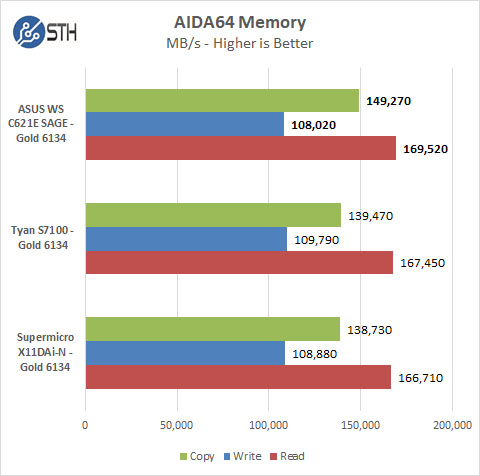
Cinebench R15
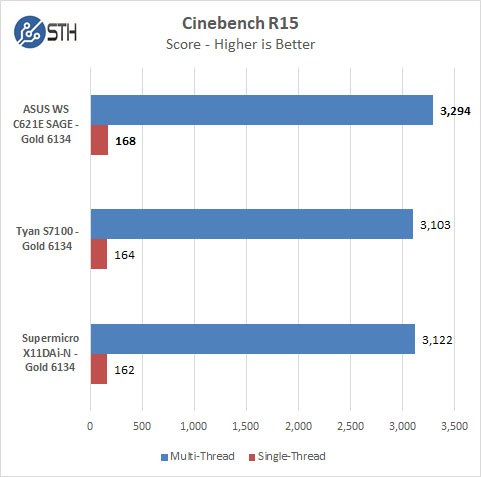
Geekbench 4
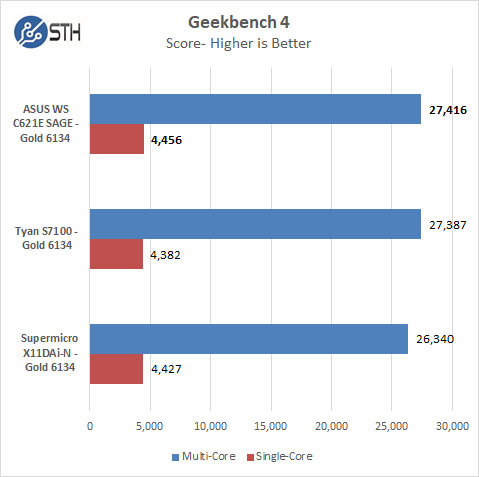
PCMark 8
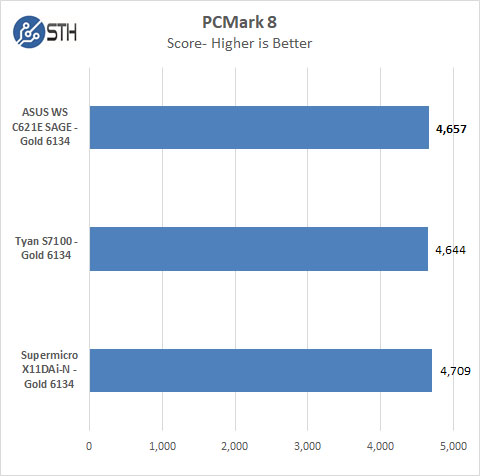
PassMark 9
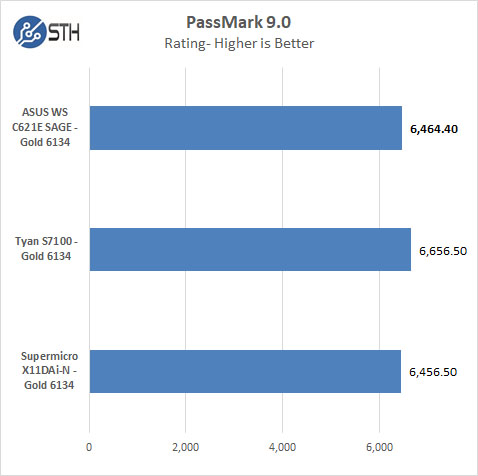
Overall, the ASUS WS C621E SAGE performed extremely well. If you are building a high-end workstation using Windows Server 2016 for example, and are using frequency optimized parts, this is a great option to maximize per core performance. There is a bit more room to overclock, normally around 3% that can help these numbers even more.
Next, we are going to look at the power consumption before getting to our final thoughts.


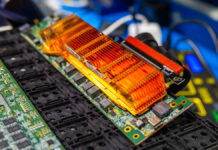
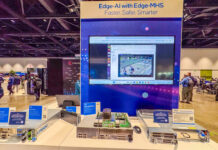
How long do ASUS tend to support their workstation mb offerings?
Regular desktop boards (even the ROG and the like) tend to not receive BIOS updates and the like for long after release, or they take a really long time to fix security issues. (Sabertooth X99 for example, still no BIOS with Spectre v2 microcode fix)
Which coolers did you use for the review?
I used Square ILM Socket LGA 3647 B13 Heatsinks from Dynatron.
I have found the WS boards get needed updates when it is required.
@Meow
Just did a quick Google. ASUS has a timeline for Meltdown et al (obviously not an ordinary update) but whether or not you find the usual BIOS support life for the Z10 and Z9 WS boards acceptable is up to you. Links below.
https://www.asus.com/au/support/FAQ/1035538
https://www.asus.com/us/Commercial-Servers-Workstations/Z10PED16_WS/HelpDesk_BIOS/
https://www.asus.com/us/Commercial-Servers-Workstations/Z9PED8_WS/HelpDesk_BIOS/
One negative point, i have the ASUS X299 PRO/SE motherboard, which is the same as this one but with the X299 chipset and it also has the ASMB9-iKVM features.
The KVM console function does not work properly when using a discrete graphics card with multiple monitors. The KVM tries to use the onboard chip for graphics which means you cant control it.
Example, i have a 1070TI with 3 monitors, the onboard KVM (AST2500) acts as a 4th monitor. The KVM now displays only one monitor (the 4th) but acts as 4 monitors, which means the mouse is uncontrollable and windows arent visible (they open on one of the other monitors)
Asus knows about this and says its working on a fix, but its not out yet.
Also many sensors are marked as critical for me, even some voltages, this is also a problem recognized by Asus in the KVM firmware, waiting for a fix.
Oh and another note, i wasnt able to view the BIOS via KVM either, because it was displayed on another monitor as well, so the screen stays black untill booted and logged on.
Asus just released a new bios with option to select main GPU (onboard/discrete) so i will be trying this soon.
I’d avoid ASUS and go SuperMicro every time.
I have found ASUS’s BIOS updates to be lacking and they tend to stop being issued far too soon IMO.
Warning!: The SQUARE heatsink will not fit! Make sure to buy a NARROW heatsink like the Supermicro SNK-P0068AP4
The Square ILM heat sink is the one fits this board. I noted that and which one I used in the review.
Have someone tried a hackintosh on this C621E SAGE motherboard?
People have it running stable on C422 chipset (with Xeon-W); forum thread: https://www.insanelymac.com/forum/topic/333229-help-installing-highsierra-on-xeon-w-2175-and-asus-ws-c422-mobo/?do=findComment&comment=2611882
I don’t see mention of the form factor, which is (disappointingly) EEB. I’m wondering what type of case you used.
See this thread for running hackintosh: https://www.tonymacx86.com/threads/asus-announces-ws-c621-sage-dual-socket-lga-3647.235505/ No one yet but will happen at some point I think.
I’ve been running a very stable Dual Xeon hackintosh workstation on Z9PE-D8 WS for years (still faster than latest Mac Pro and a lot easier to expand!).
Like any multi-CPU board they can take a bit of coaxing to get the drivers/kext right but performance and stability are excellent.
On Ubuntu 18.04.1 LTS (4.15.0-43-generic) dmesg shows the following error:
[ ] pci 0000:00:00.0: aer_layer=Data Link Layer, aer_agent=Receiver ID
[ ] {29}[Hardware Error]: Hardware error from APEI Generic Hardware Error Source: 0
[ ] {29}[Hardware Error]: It has been corrected by h/w and requires no further action
[ ] {29}[Hardware Error]: event severity: corrected
[ ] {29}[Hardware Error]: Error 0, type: corrected
[ ] {29}[Hardware Error]: section_type: PCIe error
[ ] {29}[Hardware Error]: port_type: 4, root port
[ ] {29}[Hardware Error]: version: 3.0
[ ] {29}[Hardware Error]: command: 0x0540, status: 0x0010
[ ] {29}[Hardware Error]: device_id: 0000:00:00.0
[ ] {29}[Hardware Error]: slot: 0
[ ] {29}[Hardware Error]: secondary_bus: 0x00
[ ] {29}[Hardware Error]: vendor_id: 0x8086, device_id: 0x2020
[ ] {29}[Hardware Error]: class_code: 000006
[ ] pci 0000:00:00.0: aer_status: 0x00000040, aer_mask: 0x00000000
[ ] Bad TLP
xcxc,
Did you manage to find out what the error was?
Can you reply so we can chat offline re specs etc?
Having same issue where the MoBo/Computer locks up/crashes at random times.
xcxc,
I’m facing the same errors with CentOS 7.5 (kernel 4.20).
Did you find what is wrong ?
Hi,
I’m not able to access the UEFI BIOS (only the blue legacy BIOS)
Therefore I’m not able to install my Intel SSDs using the U.2 ports.
Does anyone had similar issues with the Board.
Asus support is not able to fix the issue.
Thanks!
Sinux and Oded,
Did the latest BIOS update and it fixed the errors that I was getting
Hi Turkishlitecoin
Great that it worked for you.
I also have installed the latest version 3601.
It still does not work.
Here’s what happens after resetting CMOS:
youtu.be/r08Lk–O6bM
Any idea what’s wrong with the board?
This compatable to have 2x Ryzen Thread Ripper Pro’s 3995WX